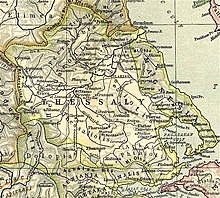Histiaeotis

Histiaeotis (
Thessalian tetrarchy, roughly corresponding to the modern Trikala regional unit. Anciently, it was inhabited by the Hestiaeotae (Ἑστιαιῶται), and the Peneius may be described in general as its southern boundary. It occupied the passes of Mount Olympus, and extended westward as far as Pindus.[1][2] The demonym of the district's inhabitants is Histiaeotes (Ἱστιαιῶται, Histiaiotai). In epigraphy, the regional name occurs as Hestiotai,[3] ambassadors in Athens and Histiotai[4] in the Thessalian grain decree for Rome (see Pelasgiotis) but most similarly written names are related to Histiaea, an Attic deme and a city in North Euboea. The epigraphical Aeolic Greek vocalism of Hestiaeotis is bizarre and idiomatic.[5]
Histiaeotis is first mentioned by
Thessalian conquerors from Thesprotia
.
Perrhaebians took possession of it, who had already subdued Histiaea in Euboea and had forced its inhabitants to migrate to the mainland, they called the country Histiaeotis after these Histiaeans, because of the large number of these people who settled there"; but this is an uncertified statement, probably founded alone upon similarity of name. Homer mentions another ancient tribe in this part of Thessaly called the Aethices, who are placed by Strabo upon the Thessalian side of Pindus near the sources of the Peneius. They are described as a barbarous tribe, living by plunder and robbery.[11][12][13][14]
Strabo adds that Histiaeotis and Dolopia comprise Upper Thessaly, which is in a straight line with Upper Macedonia, as is Lower Thessaly with Lower Macedonia.[15]
The towns of Hestiaeotis were:
.Notable sanctuaries of the region were of
Machaon
".
Pharkadon
.References
- ^ Pliny. Naturalis Historia. Vol. 4.1.
- ^ Strabo. Geographica. Vol. ix. pp. 430, 437, 438. Page numbers refer to those of Isaac Casaubon's edition.
- ^ [Ἑ]στ[ι]ωτ[ῶ]ν
- ^ Ἱστιώτας
- ISBN 0-521-83307-8(2007)
- ^ Herodotus. Histories. Vol. 1.56.
- ISBN 978-0-19-282425-7.
- ^ Homer. Iliad. Vol. 2.749.
- ^ Aeschin. de Fals. Leg. p. 122
- ^ Strabo. Geographica. Vol. ix. pp. 439, 440. Page numbers refer to those of Isaac Casaubon's edition.
- ^ Homer. Iliad. Vol. 2.744.
- ^ Strabo. Geographica. Vol. vii. p.327, ix. p. 434. Page numbers refer to those of Isaac Casaubon's edition.
- ^ Stephanus of Byzantium. Ethnica. Vol. sub voce Αἰθικία<.
- ^
 Smith, William, ed. (1854–1857). "Thessalia". Dictionary of Greek and Roman Geography. London: John Murray.
Smith, William, ed. (1854–1857). "Thessalia". Dictionary of Greek and Roman Geography. London: John Murray.
- ^ Strabo. Geographica. Vol. 9.5.17. Page numbers refer to those of Isaac Casaubon's edition.
- ^ Iliad 2.729 Archived 2009-10-02 at the Wayback Machine
![]() This article incorporates text from a publication now in the public domain: Smith, William, ed. (1854–1857). "Thessalia". Dictionary of Greek and Roman Geography. London: John Murray.
This article incorporates text from a publication now in the public domain: Smith, William, ed. (1854–1857). "Thessalia". Dictionary of Greek and Roman Geography. London: John Murray.
